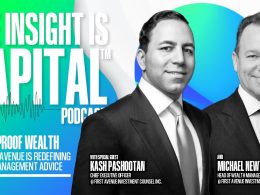by Chris Fasciano, Chief Market Strategist, Commonwealth Financial Network
I am a firm believer that the market doesn’t like uncertainty. That reality has been seen on more than one occasion in 2025, most notably post-Liberation Day. As discussed in last week’s post, uncertainty hasn’t disappeared—even after the pause in the trade war between the U.S. and China. One of the other investing tenets I believe in is that when things look the bleakest, the market embraces less bad news. And that reality has been evident recently, with the S&P 500 rallying more than 22 percent since the year-to-date low on April 7.
Positive News on Tariffs
The recent rally began when Treasury Secretary Scott Bessent struck a more conciliatory tone with China, saying he expected a de-escalation shortly. That came after last weekend’s negotiations, with the U.S. and China announcing they had agreed to pause their trade war. Tariffs were rolled back to lower-than-expected levels, a positive surprise for investors and markets. Further, the 90-day pause gives the two countries time to negotiate a longer-lasting deal and removes short-term economic risks.
Inflation Trending Lower
This week also brought good news on the inflation front. Although tariffs could still impact inflation, current readings continue to trend lower and closer to the Fed’s goal of 2 percent inflation growth. The chart below shows core CPI, which removes the impact of volatile items like food and energy. Economists believe this is a better measure of the underlying long-term path of inflation.

Source: The Daily Shot
In addition, despite a strong March for retail sales as consumers bought ahead of tariffs, April showed growth. It was certainly small at 0.1 percent. Still, it indicated that consumer demand remains strong.
Markets Rally, Earnings Expectations Decline
Turning to the markets, have investors grown too comfortable with the narrative for an improving outlook? The S&P 500 has been up in 15 of the past 18 days. In the short term, rising prices have led to higher stock valuations. At the market low in April, the S&P 500 traded at 18x forward earnings estimates. Currently, the market is over 21x earnings, as seen in this chart:


The rally has been broad-based, as valuations for both the big growth companies at the top of the index and the remaining 490 stocks have risen. But it has also occurred at a time when earnings estimates have been declining. Expectations for earnings entering 2025 were for 15 percent growth for the S&P 500. Currently, estimates have declined to levels that indicate growth of just over 9 percent, as can be seen in this chart showing consensus estimates:

Source: FactSet, as of May 9, 2025
As they wait to see how tariffs play out, corporations have given cautious guidance about their business outlooks or, in some cases, not given guidance at all.
Is the Rally Sustainable?
Recently, there have been better headlines for investors to grab onto and use to justify a stock rally. The good news is that investors are doing so knowing that earnings might be subdued this year. This indicates they could be looking ahead to 2026, when growth is expected to return to 13 percent.
The key to the path forward for the markets will be whether investors are truly ready to look through any potential weakness in the economy or an increase in inflation. While the news on pauses and blueprints for deals is welcome, the uncertainty created by the on-again, off-again policy announcements and the tariffs already in place should have some impact on the economy.
Soft data like consumer surveys has deteriorated, but those concerns have yet to show up in the hard data. Much of this measurable data has been backward-looking. We will certainly be focused on any economic reports that begin to show the impact of tariffs on the hard data, with monthly employment reports being the key to the future of the consumer.
With 10 percent universal tariffs in place and other sector-focused tariffs that have been announced, their impact remains to be seen. Yesterday, Walmart mentioned it was becoming more challenging to avoid raising prices and anticipates it will do so shortly. It is important for investors that the administration continues to make progress on trade deals with other countries, which would further reduce the impact of tariffs on prices and supply chains in the second half of the year.
We will also be watching the progress of the budget bill working its way through Congress. While numerous hurdles remain, getting this legislation passed should help avoid another showdown on the debt ceiling and potentially provide some economic stimulus as we move forward. This could offset some of the impact of tariffs on economic growth.
Revisit Investment Goals
We are just five weeks removed from peak uncertainty around tariffs and heightened investor emotions and concerns about the future. Given the strong rebound we have seen for stocks, now is a good time for investors to revisit long-term objectives and ensure that they are appropriate—and then make sure their portfolios are constructed to achieve those plans. It is much easier to make changes from a position of strength than it is when everything seems bleak.
As I’ve written before, there are various strategies investors might consider to ride out volatility. Applicable ones might be rebalancing and using a bucket strategy. Each year, we experience market volatility and a sell-off. Preparing now for whenever and why it happens again is sound long-term financial planning.
*****
Chris Fasciano is the Chief Market Strategist at Commonwealth Financial Network, the nation's largest privately held independent broker/dealer-RIA.
Forward-looking statements are based on our reasonable expectations and are not guaranteed. Diversification does not assure a profit or protect against loss in declining markets. There is no guarantee that any objective or goal will be achieved. All indices are unmanaged and investors cannot actually invest directly into an index. Unlike investments, indices do not incur management fees, charges, or expenses. Past performance is not indicative of future results.
Commonwealth Financial Network is the nation's largest privately held independent broker/dealer-RIA. This post originally appeared on Commonwealth Independent Advisor, the firm's corporate blog.
Copyright © Commonwealth Financial Network














